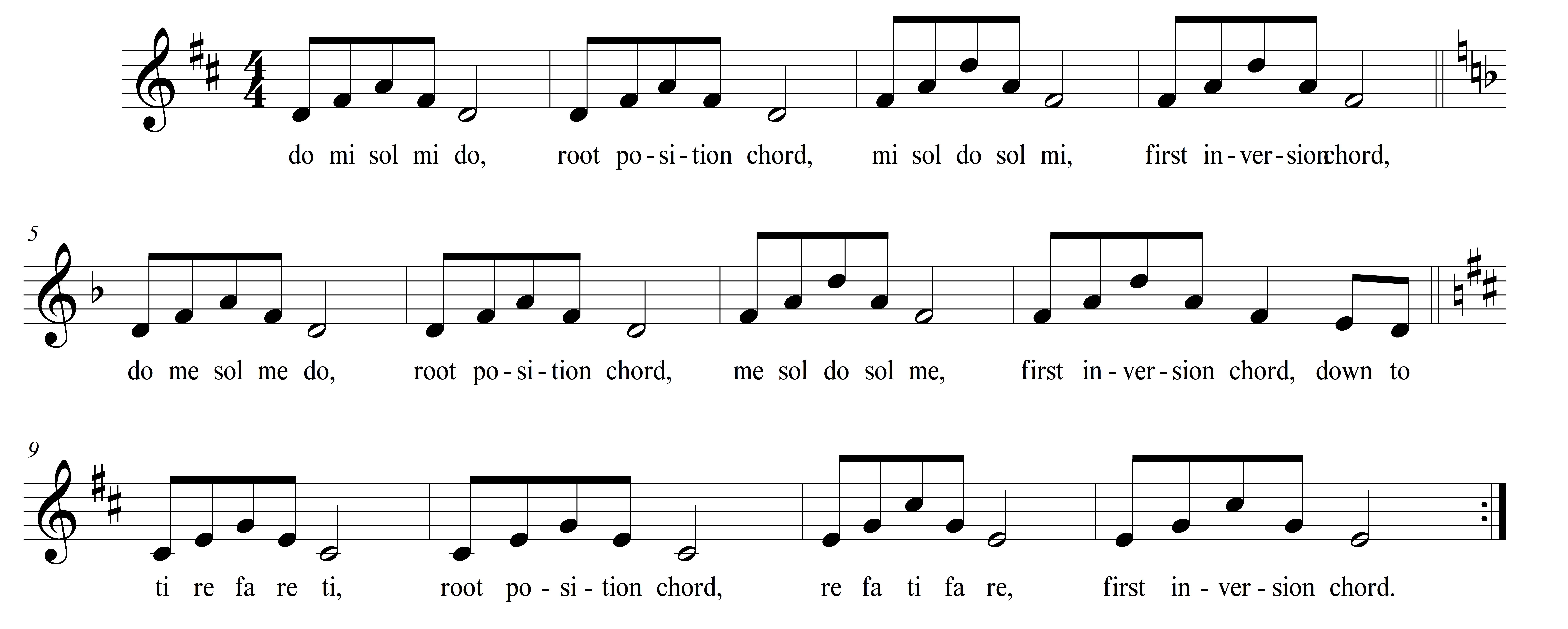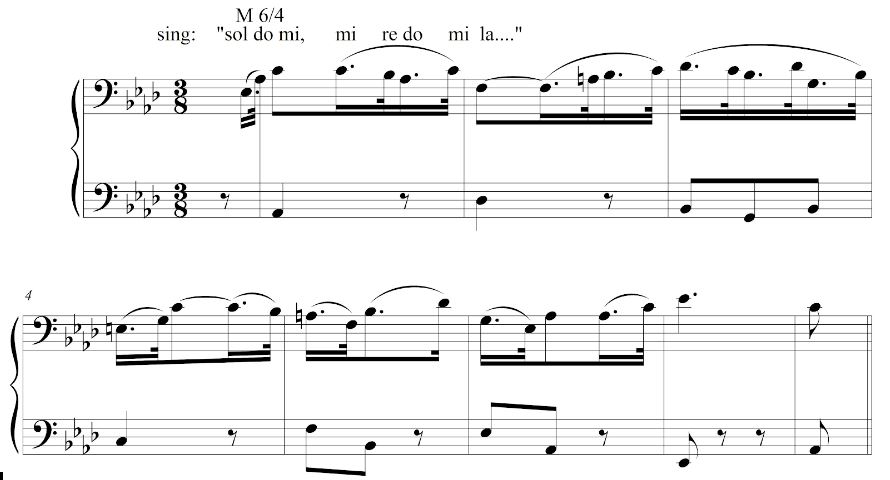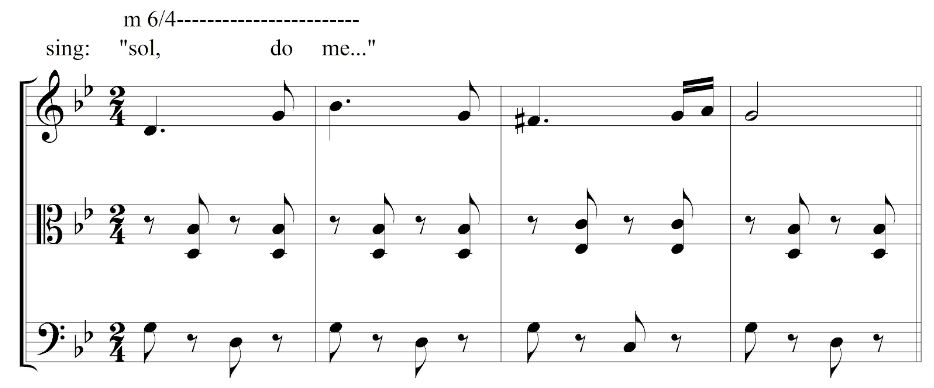Integrated Aural Skills 2018-19
Ear Training - Triads in Review
Triads - Review of the Principles
-
The major triad is composed of a stacked major third plus minor third. The two commonest ways it appears in diatonic harmony are as chord I in a major key (do-mi-sol), and chord V (sol-ti-re) in major AND minor keys. It’s also very common for it to appear as chord IV in major keys (fa-la-do).
-
The minor triad is composed of a stacked minor third plus major third. It also occurs within the diatonic scale. In minor keys, it appears most commonly as chord i (do-me-sol). In major keys, it appears commonly as chord ii (re-fa-la) and as chord vi (la-do-mi).
-
The diminished triad is composed of two stacked minor thirds. It functions as chord vii0 in both major and minor keys, as well as chord ii0 in minor keys. In this class, we will always spell this chord ti-re-fa when we are singing it outside of a melodic or harmonic context. Please don’t attempt to spell or sing the diminished triad do-me-se. Not all chords relate to do, and this spelling has no context in diatonic music.
-
The augmented triad is composed of two stacked major thirds. It is relatively rare in diatonic harmony. It doesn’t naturally occur within the tones of the diatonic major scale, and sounds very chromatic. For this reason, many learners find it hard to sing. When it does occur, it is usually spelled sol-ti-ri and appears as a chromatic variant of the dominant (sol-ti-re). We also find it as chord III+ in harmonic minor; again, this is relatively rare.
Memorize Triads and Their Functions in Root Position
Sing and memorize the following excerpt, which teaches the four types of triad and their common solfege and function. If you habitually confuse diminished with augmented triads, internalizing these principles will help.

Inverting the Triads
When we spell a triad in such a way that the lowest pitch is a note other than the root of the triad, we say that it is inverted. Because triads have three pitches, there are two possible inversions, which we call first inversion and second inversion.
Triads in root position are composed of a root, third degree, and fifth degree. In music terminology, we refer to a root position triad from the “top down” as 5/3. Memorize this chart that describes the terminology of how we spell the triad and its first and second inversions, including common abbreviations used to notate figured bass.
| Position | Description | Notation in Figured Bass Analysis |
|---|---|---|
| Root Position | 5/3 | (can leave out) |
| First Inversion | 6/3 | 6 |
| Second Inversion | 6/4 | 6/4 |
Identifying Triads in Inversion
Step 1:
- Listen to the “color” of the triad. Often you will be able to tell the chord quality from only one hearing. Major and minor tend to be unmistakable. Be careful to distinguish between augmented and diminished triads, the two dissonant ones. If unsure, listen contextually, using your solfege and diatonic harmonic logic.
Step 2:
- Listen to the triad intervallically. An inverted triad will have some kind of fourth (a larger interval than a third) in it. In major and minor, there will be a perfect fourth. In a diminished triad, there will be an augmented fourth. In an augmented triad, the symmetricality of the chord means that all intervals will “sound like” major thirds, regardless of the inversion and notation, because a diminished fourth is enharmonically equivalent to a major third. For this reason, you may identify all augmented triads as 5/3 in tests.
First Inversion (6/3) Triads in Context

- Major 6/3 is composed of a stacked minor third + perfect fourth
- Minor 6/3 is composed of a stacked major third + perfect fourth
- Diminished 6/3 is composed of a stacked minor third + augmented fourth
- Augmented 6/3 is composed of a stacked major third + diminished fourth…but in this class, you can identify and notate it as 5/3 only because of its “symmetrical” nature.
Confusing root position with first inversion? Learn and memorize this easy song.

As always, well-known repertoire provides memorable contexts for inverted triads. The famous trumpet solo from Stravinsky’s Petrushka outlines a major triad in first inversion. Listen to the track below several times.
Second Inversion (6/4) Triads in Context
In the early stages of chord and inversion identification, learners often confuse 6/3 and 6/4 triads. If you are confused, listen carefully for the presence of the larger interval – the fourth. In major and minor triads, the fourth will be perfect; in diminished triads, it will be an augmented fourth. In second inversion triads, the two lowest pitches will form the larger interval.
Study and listen to these common contexts for second inversion triads. In the first example, the opening of the second movement of Beethoven’s Symphony No. 5, the first three pitches of the melody form an ascending second inversion major triad.
By contrast, study and listen to the opening of Brahms’s Hungarian Dance No. 5. The first three pitches of the melody form an ascending second inversion minor triad.
Listen to the Spotify playlist below several times until you know both compositions well. Also in the playlist is Chopin’s “Raindrop” Prelude, a famous example of the the major 6/4 triad played in descending motion. Can you sing along in solfege?

